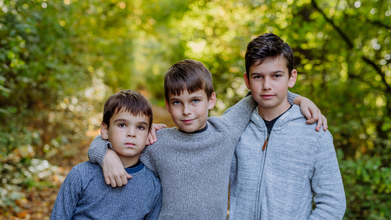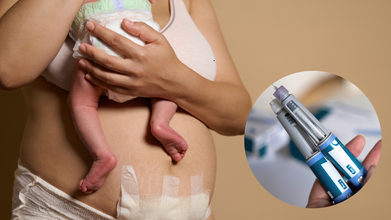- Health Conditions A-Z
- Health & Wellness
- Nutrition
- Fitness
- Health News
- Ayurveda
- Videos
- Medicine A-Z
- Parenting
Why It’s Okay Not To Be A Perfect Parent- Lessons For New Parents

Why It’s Okay Not To Be A Perfect Parent- Lessons For New Parents
"I still remember that first time when my parents took me aside for what would turn out to be one of the most memorable conversations of my life. And so, I had only just finished my first gig as a drummer for a local band; although my parents weren't particularly keen on my choice of hobbies, they attended, cheered, and clapped. In my case, after the show, I was beaming with excitement, but my parents, without diminishing my enthusiasm, asked me what I had learned from the experience. That moment for me was a moment of crystallization, wherein I realized that my parents were not only supporting me but also helping me grow and introspect, eventually owning all the choices I made," narratives Raghav, now a sports psychologist in Bengaluru.
It has been very appealing in such a world with loads of parenting advice and parenting manuals to peruse often on what makes good parents perfect. It's about being perfect; it's not. It's about setting up a place where your child can flourish, where mistakes are an inherent part of the path you take, and love can be felt even through disagreements.
As we all explore our own experiences and those of others who had "good parents," there are some common threads that truly stand out — lessons that new parents can carry with them as they chart their own parenting journey.
Support Without Understanding
One important thing I learned from my parents is that you can never really understand the passion of your child in order to really support it. Not that my parents were not interested in skateboarding at all; however, they were willing enough to spend hours driving my brother to skateparks and continually buying new gear. They did not impose their dreams on us but allowed us to discover our own paths, even when that seemed out of step with theirs.
Similarly, though they did not reveal to me their love for drumming, they made quite an effort to enable me to pursue my dream. This freedom to explore taught me such an important life lesson : I am responsible for my own happiness. My parents were willing to support what they did not fully understand, giving me that courage to be passionate about things without fearing judgment.
New parents should remember that they don't have to micromanage everything their child might be interested in; it's all about giving them the space to find joy on their own terms and not to make them do something they are not deeply passionate about.
Power of Not Sheltering
The majority of parents have the instinct to protect their children from the pain or disappointment they will cause by being hurt or let down. My parents were entirely different. I was never sheltered nor protected from the harshest realities of life. My parents encouraged me to lose at sports, rejection, and to experience the diversity of society in all its implications-whether that was through having interactions with people from a different socioeconomic class or watching loved ones undergo difficult situations.
Instead of sheltering me from every knock and bump that came my way, they let me hit bottom and provided a pillow for me to fall on when the going got tough.
This should expose children to reality while at the same time providing support to help develop resilience. First-time parents will often find themselves wanting to protect their child from the upheavals of life, but, as it turns out, resilience is actually forged in the fire of trial. The children must be exposed to the capability to move through difficulties with support, not separation from the ease of life.
Leading by Example
My parents never asked me to do anything that they had not done themselves. If they taught us how to budget, then they themselves were under tight financial discipline. If they wanted us to treat people with kindness and respect, then they embodied those values in their dealings with others. They lived by the lessons that they would teach, so I found it easy to emulate them.
Indeed, one of the most powerful tools a parent has is leadership by example. Children are such observers, and they learn much more from what you do than from what you say. Want your children to live with integrity, discipline, and compassion? First, you must model those traits.
Breaking the Cycle of Trauma
The most important lesson I learned from my parents is breaking the cycle of trauma.
Both my parents are products of hard childhoods. While I was brought up by strangers much of his childhood, my father was abandoned. My mother suffered abuse from her own step-mother. They carried many scars, but they chose to give me and my siblings a life free from such pains.
Not perfect, to be sure-no parent ever is-but they made a conscious effort to build a loving, stable family environment. That this struggle means you are liberating yourself from your past and giving your children an opportunity for better life generally reminds us of something so important: no matter how one grows up, they can always choose to be different in parenting.
This is a good reminder for new parents- your past doesn't determine how you raise your children. You can create a nourishing home filled with love, even in the midst of serious struggles.
Respect and Fairness
One thing I was extremely thankful for while growing up was how my parents showed me and my siblings that they were fair. No one was a favorite, nor was anybody treated differently for some unknown agenda for others. Nothing was administered without some form of explanation, and decisions were always opened for discussion. It was never, "because I said so.".
This approach to parenting tended to build a relationship on mutual respect and trust. I never had the rebellion phase, not so much because I didn't want to be the rebel but I always felt heard. This is a very important lesson that new parents must know: respect breeds respect. By treating your child as a thinking human being who can engage in conversation, you help him grow into a responsible adult.
Parenting is a journey - well, my gosh; it's something that has been through loads of moments of doubt, learning, and growth. My parents aren't perfect, but they got a lot right: provided me with the space to focus on those things that interest me, allowed me to go through the ups and downs in life, modeled behavior for me to follow, and most importantly, they broke the cycle of trauma to give my siblings and me a better life.
So, you're not trying to be perfect; you're trying to love them, support them, and grow with them. Parenting is that process of providing a space where your children feel empowered to make their choices and supported in their pursuit, with values that you live each day. Parenting is not just protecting children from the world, but building resilience for life.
Older, Younger or Middle Child: Does Birth Order Shape Your Personality?

Credits: iStock
Are you a younger sibling in your family and you relate to other younger siblings? Do you feel some of your habits and traits match other younger siblings? Or are you the middle child and you feel that sometimes you are excluded. When you talk about it, other middle children also agree with you. If this is the case with you, then you may be interested to know the Birth Order Theory.
This theory was developed by Alfred Adler in 1964, who focused on the importance of birth order on personality development. In this theory, he says that though children may be born into the same household, their birth order greatly influence their psychological development.
As per Adler's birth order theory, a child could have certain personality traits which are as followed:
- The Oldest Child: more authoritarian, and feels powerful due to high expectations set by the parents
- The Youngest Child: treated like a spoiled baby and cannot rise above the other siblings
- The Middle Child: even tempered, but has trouble fitting in as they have always been sandwiched between the younger and the older siblings
However, for middle child, their characteristics would often get itself a term, called the Middle Child Syndrome.
What Exactly Is A Middle Child Syndrome And What Sets Them Apart From Their Younger And Older Siblings?
Middle child syndrome is the belief that middle children are excluded, ignored, and neglected because of their birth orders.
People often talk about “middle child syndrome,” the idea that the child who is neither the oldest nor the youngest develops a very particular personality. While some of this comes from family dynamics rather than science, many families do notice certain patterns.
Personality Traits
Middle children sometimes feel overshadowed by their siblings. The oldest is often seen as responsible and strong-willed, while the youngest gets extra attention for simply being the baby of the family. The middle child may end up somewhere in the middle of all this, which can make them quieter, more even tempered, and sometimes unsure of where they fit in.
Family Relationships
When it comes to parents, middle children might feel that they do not get the same level of attention as their siblings. The older child usually carries more responsibility, and the younger child often gets extra care and protection. The middle child may feel they slip through the cracks and receive less one-on-one time with their parents.
Sibling Rivalry
Feeling unseen can spark a sense of competition. Many middle children find themselves competing for attention from both parents and siblings. At the same time, they often become the peacemaker of the family simply because they are used to being in the middle of everything.
Feeling Left Out of Favoritism
When parents unintentionally favor the oldest for their achievements or the youngest for their sweetness, the middle child may feel they are no one’s first pick. They are not the trailblazer or the baby, and this can shape how they see their place in the family.
Carrying These Feelings Into Adulthood
Some people believe that these early experiences can follow middle children into adulthood. If a middle child grew up feeling overlooked, they might struggle with co dependency or constantly try to keep the peace in relationships. They may also find it difficult to believe they can be someone’s closest friend or favorite person.
Their personalities often seem muted when it is compared to the other siblings, this is because they have always blended into the background. These patterns can show up at work, in friendships, and in romantic relationships.
What Research Actually Shows
Although middle child syndrome is talked about a lot, scientific research has not clearly confirmed it. There have been studies that show some truth to the theories, while others deny. Some research suggests that middle children do feel less close to their parents or are less likely to turn to their parents when they are going through stressful times in their lives. A 2019 study showed that middle children were less likely to feel comfortable talking to their parents on topics like sex education. Though it is important to note that this is a broad topic to begin with, and could have cultural variations.
Other studies have suggested they might be less family oriented or more prone to certain perfectionistic traits. But these findings are not consistent across research. In fact, a number of large studies show no strong link between birth order and major personality traits such as extraversion, emotional stability, or agreeableness.
Some studies even contradict each other entirely. For instance, one study suggested middle children might have a higher risk of depression, while another found that oldest children were more likely to experience mental health issues.
So Does Middle Child Syndrome Exist?
With so many conflicting findings, scientists cannot say for sure. Many experts believe that personality is shaped by a mix of family environment, parenting styles, cultural background, and individual temperament. Birth order may play a small role, but it is unlikely to be the determining factor.
In short, middle child syndrome is more of a popular idea than a proven scientific fact. Each child’s experience is unique, and many different influences shape who we become.
More New Moms Turning to Ozempic After Birth, But Experts Are Worried

Credits: iStock
Danish researchers were studying the use of medicines on women during and after pregnancy. What they realized is that number of women consuming Ozempic and Wegovy after childbirth has increased. As per their observation, in 2018, less than 5 prescriptions for every 10,000 women post six months of their childbirth were there. However, this number increased to 34 in mid-2022, and by mid-2024, there were 173 prescriptions.
That comes close to 2 percent of all postpartum women. Most of these women were in their 30s, had more than one child, and while many were overweight, they did not have diabetes. They also had no previous history of using GLP-1 medications.
This spike surprised researchers because the postpartum phase is usually a time when the body naturally sheds some pregnancy weight and undergoes major hormonal changes. “In a period characterized by natural weight loss and marked hormonal change, this was unexpected,” said Mette Bliddal, a pharmacologist at the University of Southern Denmark and the study’s first author, as reported by the New York Times. The findings were published in JAMA.
How Was The Study Conducted?
The analysis reviewed 382,277 pregnancies in Denmark from early 2018 through June 2024. Researchers used national health registries to track every live birth and every prescription filled for GLP-1 drugs during the postpartum period. This made it possible to see the rise in real time.
Although semaglutide, the ingredient in Ozempic and Wegovy, is widely used for weight loss, its safety in the months after childbirth is still unclear. This is a time when many mothers are breastfeeding and adjusting to changing hormone levels, sleep disruptions, and recovery from pregnancy.
What We Know and Don’t Know About Breastfeeding Safety
Right now, evidence around the safety of GLP-1 drugs for breastfeeding mothers is very limited. While semaglutide has not been detected in measurable amounts in breast milk and no immediate negative effects have been seen in infants, researchers caution that long-term effects on a baby’s metabolism, growth, or pancreas remain unknown.
Major medical groups are also hesitant to give a firm recommendation. The American College of Obstetricians and Gynecologists has not released guidelines because the drugs are too new and the data isn’t strong enough. First Exposure, a Canadian research network that evaluates drug safety in pregnancy and breastfeeding, advises against using these medications while breastfeeding. They also recommend stopping them one to two months before trying to conceive.
Experts say the caution comes from the lack of solid research. GLP-1 drugs are large molecules that usually do not transfer easily into breast milk and would likely break down in a baby’s stomach. Still, the uncertainty is significant enough that researchers prefer mothers avoid them during breastfeeding.
Why Researchers Are Concerned
Another concern is that these appetite-suppressing medications could affect milk production, nutrient content, or even leave mothers dehydrated. Dr. Bliddal noted that the postpartum period is a time when “the body is working hard to regain its balance.” Without knowing how weight loss drugs interact with these processes, many specialists believe it is safer to avoid them until more is known.
Even small changes in breast milk composition could matter for infant development. Since there is no clear data on how GLP-1 drugs might alter fat content or nutrients in breast milk, researchers urge caution.
Vanessa Hudgens Becomes Mother Again At 36; Is Late Pregnancy Safe For Women?

Credits: Instagram
Vanessa Hudgens at the age of 36 is a mother again. She welcomed her second baby with husband Cole Tucker. The news was announced on Instagram on Saturday, where she shared a photo of herself lying in a hospital bed, holding Tucker's hand.
She wrote: "Well…. I did it. Had another baby!! What a wild ride labor is. Big shout out to all the moms. It’s truly incredible what our bodies can do ❤️."
This month itself, Catherine Paiz revealed that she was pregnant with her fourth baby at the age of 35.
These news of celebrity pregnancy after 30 spark the spotlight on late motherhood and how safe it really is?
What Does The Data Tell Us On The Trend Of Late Motherhood?
The average age of mothers in the US have continued to rise, a new report released on June 13 by the National Vital Statistic System (NVSS), provides the shift in age trends between 2016 and 2023. The study, conducted by Andrea D. Brown, Ph.D., M.P.H., and her colleagues at the National Center for Health Statistics.
The researchers found a clear increase in the mean age of mothers at the time of their first birth. In 2016, the average age of a first-time mother was 26.6 years. By 2023, this had risen to 27.5 years — nearly a full year’s difference in just seven years.
But the trend isn’t limited to first-time mothers. In Paiz's case, she is having her fourth child at 35.
Is Late Pregnancy Healthy?
The National Institute of Health (NIH), US (2022), 20% of women in the US are now having their first child after the age of 35. While it is the new trend, the NIH doctor Dr Alan Decherney, a fertility expert explains that "As women age, they are still fertile, but their odds of pregnancy are decreased because they are not making as many good eggs that will fertile and divide normally and turn out to be an embryo."
After age 30, a woman's fertility decreases ever year, notes the NIH July 2022 issue. It notes: "The number and quality of her eggs goes down until she reaches menopause."
However, experts do point out that getting pregnant in your 30s need not be a stressful affair at all times. As it is at this age when you experience more stability, and also someone you know who have a personal experience in handling one. Most important, you are more mature at this age, which you may not be in your 20s.
What Must You Keep In Mind If You Plan Pregnancy After 30?
Quit Habits: If you are a smoker, or consume alcohol, this is a good time to leave it.
Reduce Stress: While pregnancy for some can bring stress, try to find activities that help you release it.
Healthy Weight: Ensure that your weight is right, reduce your waist to bring it to a healthy range for a healthy pregnancy.
Food Habits: Stop eating junk and start eating more whole grains.
Exercise: A sedentary lifestyle can impact negatively on the child. You do not have to do HIIT, however, regular easy workouts can make both the pregnancy and delivery easy.
Dr Michelle Y Owens, professor of obstetrics and gynecology and a practicing maternal-fetal medicine specialist at the University of Mississippi Medical Center in Jackson, writes for the American College of Obstetricians and Gynecologists (ACOG) that "the longer your eggs have been around, the more likely they are to produce a pregnancy with a chromosome problem that can lead to a condition like Down syndrome. The risk goes up significantly after 35." However, she says, there is a good news. Now, we have tools to detect and respond to pregnancy complications early.
© 2024 Bennett, Coleman & Company Limited

